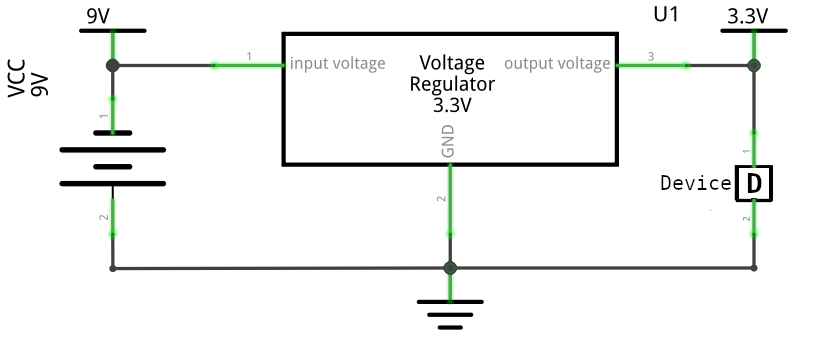This blog post gives a deeper understanding of a linear voltage regulator. A (linear) voltage regulator plays an important role as power supply. Its main function is to automatically output a constant voltage by adjusting continuously a voltage divider network. Thus, it acts as a variable resistor, where the resistance of the regulator depends on both the input voltage and the load (cf. Ohm’s law). The voltage U in units of volts equals to the resistance R in units of ohms multiplied by the current I in units of amperes:
U = R * ITo drop some voltage on the variable resistance, the input voltage VIN of the regulator must be higher than the regulated output voltage VOUT. This difference between the input voltage and the regulated output voltage (VIN - VOUT) is called dropout voltage. The regulator has to dissipate the power loss – more precisely, the multiplication of the dropout voltage and the current drawn by the circuit – as heat. Due to the waste of energy as heat regulating the voltage, a linear voltage regulator has a limited efficiency. The heat dissipated by the regulator relates directly to the average amount of electric power dissipated by the regulator. The electric power P in units of watts equals to the voltage U in units of volts multiplied by the current I in units of amperes:
P = U * I = (VIN - VOUT) * IMAXwhere VIN is the input voltage of the regulator, VOUT the regulated output voltage of the regulator powering the circuit, and IMAX the maximum current drawn by the circuit. For a safe estimation, the equation calculates the peak power with the maximum current drawn (worst-case scenario), not continuously draw by the circuit. Thus, the regulator has to dissipate more heat (power loss) as, on the one hand, the difference of the input voltage and the regulated output voltage gets greater, and/or, on the other hand, the current drawn gets greater. To expose more heat from a regulator under load, a heat sink with „fins“ increases the surface area of the regulator, cooling it more efficiently.
The figure below shows an exemplary circuit of a constant power supply of 9 volts (input voltage), a fixed voltage regulator producing a fixed DC output voltage of 3.3 volts, and an external device drawing 0.25 ampere:

Based on the three input parameters VIN, VOUT, and IMAX, the regulator has to dissipate a peak power of 1.425 watts: (9V - 3.3V) * 0.25A
Neueste Kommentare